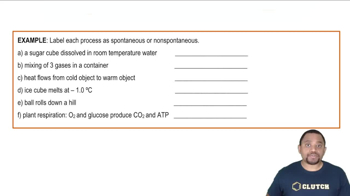(b) Assuming that there is an uncertainty of 0.002 °C in each temperature reading and that the masses of samples are measured to 0.001 g, what is the estimated uncertainty in the value calculated for the heat of combustion per mole of caffeine?
The Sun supplies about 1.0 kilowatt of energy for each square meter of surface area (1.0 kW/m2, where a watt=1 J/s). Plants produce the equivalent of about 0.20 g of sucrose (C12H22O11) per hour per square meter. Assuming that the sucrose is produced as follows, calculate the percentage of sunlight used to produce sucrose. 12 CO2(g) + 11 H2O(l) → C12H22O11 + 12 O2(g) H = 5645 kJ

Verified Solution
Key Concepts
Photosynthesis

Energy Conversion Efficiency

Thermochemical Equation

Use average bond enthalpies from Table 5.4 to estimate Δ𝐻 for the following gas-phase reaction of ethylene, (C2H4), oxygen, and hydrogen to form ethylene glycol (C2H6O2), which is the principal component of automotive antifreeze:
Depending on their specific usage, fuels are judged in part on energy released per unit volume and energy released per unit mass. Three prospective fuels are listed in the following table, along with their densities and molar enthalpies of combustion.
a. Rank the three fuels according to their enthalpy produced per gram.
b. Rank them according to their enthalpy produced per cm3:
At 20 °C (approximately room temperature) the average velocity of N2 molecules in air is 1050 mph. (b) What is the kinetic energy (in J) of an N2 molecule moving at this speed?
Consider two solutions, the first being 50.0 mL of 1.00 M CuSO4 and the second 50.0 mL of 2.00 M KOH. When the two solutions are mixed in a constant-pressure calorimeter, a precipitate forms and the temperature of the mixture rises from 21.5 to 27.7 °C. (a) Before mixing, how many grams of Cu are present in the solution of CuSO4?
